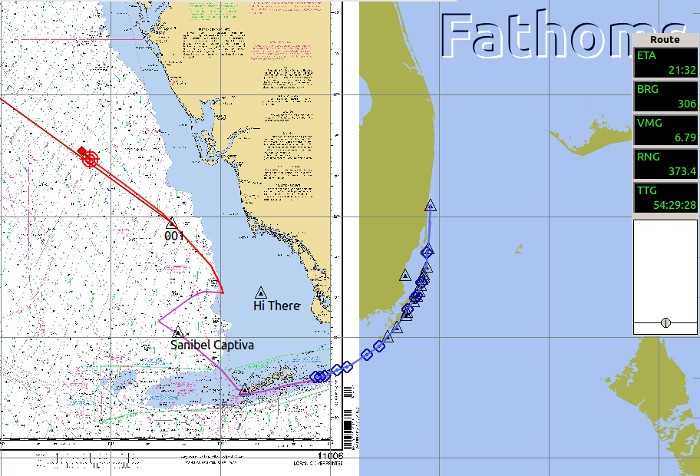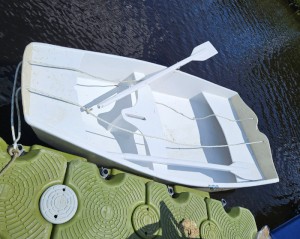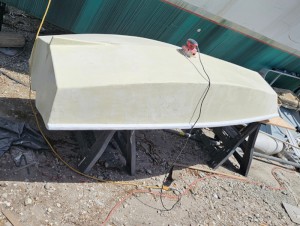Kaimusailing
s/v Kaimu Wharram Catamaran
| Vessel Name: | Kaimu |
| Vessel Make/Model: | Wharram Custom |
| Hailing Port: | Norwalk, CT |
| Crew: | Andy and the Kaimu Crew |
| About: | Sailors in the Baltimore, Annapolis, DC area. |
23 April 2024 | St Marys, GA
D4 Launchie
The laptop pooped the bed, so I have to scurry around with alternatives. Not as bad as typing on the phone.
17 April 2024 | St Marys, GA
Dinghy Skeg
I was suffering with what seemed like a cold and also had allergy symptoms. I awoke and felt fine. The green pollen that was coating everything was gone. Maybe it will return.
07 April 2024 | St. Marys, GA
Clammy Hands
Items came in from TEMU, the Chinese cut rate retailer. One was a nice little drone that cost about twelve and a half dollars. It looked like an easy thing to play with while I coughed and sneezed. I was fighting a summer cold, even though it is not summer elsewhere, it seems like it here. A nice [...]
02 April 2024 | St. Marys, GA
Sun Doggie
After laminating the cedar strips onto the gunwales of the dinghy I found the screws I used wouldn’t come out. The epoxy had seized them. The screw heads were stripped so I cut a straight slot in the heads with the cut off wheel. The cedar smoked when the screw heads got red hot. I could remove [...]
21 March 2024 | St. Marys, GA
Just Add Water
The rainy weekend started off with overcast and fog but no rain. It looked like I might be able to get something done on the D4 dinghy. I wanted to change the bow seat which is really the bow deck. The sailing option uses the deck to hold the freestanding mast. I didn’t like how the deck looked, [...]
01 March 2024 | St. Marys, GA
D4 Dinghy Alternative Seats
The rain event was more wind than rain, strong winds with gusts up to 44 mph. We drove into town to see what the harbor was like. There was a small sailboat that had dragged anchor and was sitting close to shore. The tide was out. We left and played with Bleu at Notter’s Pond.
Key West North

.
The furler line that had fouled itself was replaced with new line. The main sail batten cars that we thought were binding and making the main hard to raise were sprayed with lube. It seemed to help. I started pulling the main up as far as I could hand over hand, then put it on the winch. It seemed to me the winch was binding, it needed service.
.
The wind was from the NE and we had to sail into it as much as possible, because it was forecast to go North. To lay a course for Gulfport we had to get as much northing as possible. The Gulf was rough. It made the rough Caribbean seem like a mill pond.
.
The old AIS transceiver was removed and now we didn’t get an AIS alarm from our own boat. We were no longer colliding with ourselves. This also eliminated a continual annoying AIS antenna SWR error alarm.
.
The rough conditions were probably due to a local current, a swirl off the main Gulf Stream. The Stream pours right past the tip of Key West, North to South. The current in the Gulf itself is usually a big loop with eddies off the main current. We were making unusually good speed over the ground (SOG) compared to how our speed through the water looked. We had no gauge for speed through the water. In the old days every boat had a ship’s log, knotmeter. Nowadays I rarely see one.
.
In spite of the bouncing and jouncing I made a tuna salad with thinly sliced onions, seeded tomatoes, some coleslaw shavings, and chunky blue cheese dressing on a bed of spring greens. No one was hungry due to motion sickness, but they ate it.
.
We kept tweaking the sails. The main looked especially horrendous. The leach was falling off and nothing could be done to flatten it. Nothing normal. I took the #2 reefing line that was still rigged up and tightened it, pulling the leach flat. There was of course a strange blivet at the reefing line attachment (cringle), but most of the leach was now acceptable.
.
Skipper declared we would be putting a reef in the main and tacking over to port before sundown. I was on the 2 - 5 watch, so we decided to do it at 4:30. During the afternoon watch we were dodging many shrimp boats, up to a half dozen being around us at times.
.
We were fine tuned for upwind sailing, but the sails were not shaped well anymore, they were old and baggy. I kept the wind at 40-45 degrees off the bow and the boat sailed in the 7 knot range with 20 - 25 knots over the deck. We were getting the stuffings knocked out of us, but we were making the best of it. Our starboard tack was not taking us directly to Gulfport, but the port tack would be far worse. So why tack? The explanation is that we would be heading toward shore and be in the lee of the land. Also we would be closer to help if anything broke.
.
The tacking drill started with starting the engine. The port engine would not start so we used the starboard engine. The boat reacts to the prop when the engine is started, even if it is in neutral. The helmsman has to watch out for the boat as it takes a new direction. Then we rolled up the jib after turning into the wind. The main was lowered until the first reef point was at the gooseneck, then a line with a snapshackle was clipped on, lead through a spare rope clutch to one of the port side winches and taken up tight. Then the #1 reef line for the clew was taken up tight, then the main was raised again till the luff was tight. The jib was let out partially on the new tack. Sounds like an intricate professional sailing maneuver, if that’s the way it happened. The shrimp boat watching us must have wondered what we were doing when we got stuck in irons, backwinded, gybed the boat unexpectedly, and finally settled down on our new course.
.
Gee the boat seems so much smoother on this tack, well of course, we reduced sail. Instead of getting rest for the night watches, we were all up. It got rougher, the wind was up to 25 and more, the sea state was very short and steep. The boat was pounding, something it hadn’t done before. Spray and occasional green water hit the cabin’s from portlights. The skipper and the owner were attending to the furling line or main traveler, something at the rear of the cockpit, when a large dose of seawater firehosed them. They turned to look at me, dry in the galley, but I had my own problems.
.
It was too rough to cook, but I was giving it a try. First clean up the day’s dishes. Then get out the ingredients for a normally easy dish, pasta with a jar of spaghetti sauce thrown onto it. Also some mushrooms and garlic for flavor. Also some leftover bacon fat to sautee the mushrooms. Slice the mushrooms without slicing myself using the ultra-sharp knife that cut me the first time I had picked it up. It was so sharp. I was almost healed from that cut.
.
The stove had been acting up. We had nearly destroyed it trying to get it to work. It was a french design. We had to partially dismantle it to find out the large knob and two smaller knobs are not the stove control and two burner controls, no, the large knob is one burner control, and the two smaller knobs control another burner and the oven, take your pick which. It took a long time to figure it out.
.
Now I have a stove that only one burner worked, but it was weak. You wold expect the large burner to have a big flame and the small burner to have a small flame, but when we could get them to work, it was opposite. I took the burners apart and compared the little gas jet from each. Sure enough, the small burner had the large jet and the big burner had the smaller jet. I swapped. Now the small burner that didn’t work before still didn’t work, but the anemic big burner now had a respectable flame.
.
I now began cooking, taking forever to sautee the mushrooms. Even with the bigger jet the large burner just didn’t have much real output. It took a very long time to make this dish and I even had to throw the pasta into water that was almost boiling, not the good rolling boil they recommend on the package.
.
In the end the dish turned out to be kind of mushy, like pasta that has been sitting in water all day. But they ate it.
.
The new course took us toward Florida’s West Coast so I looked at the “overhang” of Cape Romano, the next cape to the North. If we tacked to starboard tack, then we would clear the cape. Then I looked at Sanibel and Captiva Islands that jut out further West up North above Cape Romano. When I used the measure function to compare the angle of the coast with our last good course on the starboard tack. Making a waypoint at Sanibel and Captiva and extending the course backward down to intersect our present course gave us a turning mark that would come up very quickly. The skipper would have to approve a course change and he was sleeping. We had to get him up. He agreed we should turn and we tacked, trying this time not to get stuck in irons. The owner manned the jib sheet and suggested we delay casting it off, thus backwinding the jib on the turn to tack. When we did so, the boat spun around perfectly, the jib was released hand sheeted in on the port side.
.
The skipper returned to rest and we continued on our NW course. He relieved me at 2 AM and I could now sleep till 8 in the morning. I almost did so despite the noise and jouncing of the boat. I slept to just before 7 AM.
.
I made coffee. The galley was a mess from the evening before. I had a muffin and noticed it had a touch of mold on it. We must use up our perishables. I was back on watch at 8 AM. I made a special brunch for the crew.
.
We had to use up eggs and bread, so I made super duper egg toasties. This is the usual concoction with both ham and cheese in the middle. I used up the cibata rolls and used a bagel for the skipper’s because he likes them.
.
The debate continued about what we were going to do on this leg. We were now headed for Gulfport again, but the forecast and the distance to go coincided with us hitting a 30 knot storm at the end of the leg. Also we had concerns about our fuel, with only two 26 gallon tanks our range was limited if we needed to motor, especially into the wind. We needed to run an engine twice a day to keep the batteries charged up. This boat, like most former charter boats, had no solar panels or wind generator.
.
The autopilot was a major drain on the batteries. We had frozen four 2 1//2 gallon jugs of water in the freezer and now turned the unit off and put the perishables from the fridge into the freezer. I began using up all I could before things got bad.
.
For early dinner I fried up the rest of our bacon and sliced up our last tomato and our last sub rolls. Using the spring mix lettuce I made BLT sandwiches. Now we only had a bagel and a few muffins remaining. Hopefully they won’t mold before we consume them.
.
There were thawed blueberries available for pancakes. I was now on the 5 PM watch with no contacts in sight. Wind was 15-20 from the NE and sea state was short chop that blew spray over the bows and thumped us underneath the bridge deck. Sun was setting in a clear cloudless sky. Every now and then a larger wave hit us and we pitched into the next wave with green water on deck. Our speed over the ground was in the 6-7 knot range.
.
There was a commotion below decks. The owner had gone below I thought to get some sleep, but now he had taken apart his berth to get at the space below where the engine on that side is. The skipper now joined him. What were they doing? I kept my watch and was busy adjusting sails and getting a more northerly course out of it. We could now lay Panama City on the Florida panhandle, closer than Gulfport. We could refuel there and avoid any storms.
.
They were discovering and fixing a water leak that was causing our freshwater pump to cycle continuously. We had shut off the pump and now only turned it on for a short time to wash the dishes for instance. Apparently the water heater installation had ended up with a water hose being abraded by the engines alternator belt.
.
Now we had water without the hassle of running back and forth for the pump switch. Our goal now was to head for Panama City and try to get there before the forecast front comes through. Our ETA there was about a day and a half of close reaching.
.
The image is our GPS track laid down on this computer from Dania Beach to Key West to our position off the West coast of Florida.






